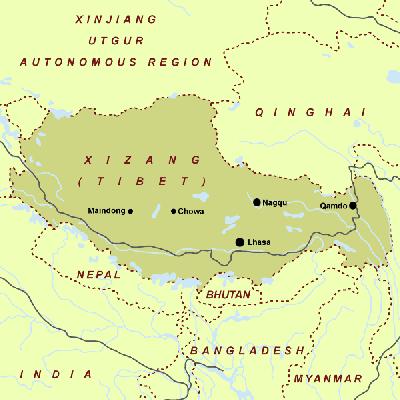| Map |
|
|
Tibet
Tibet has a highland climate, with lower temperature and less precipitation than most parts of China. It has thin air, long hours of sunshine and intense solar radiation. There is great difference in climate between the north and south -- the Northern Tibet Plateau has a mean annual temperature of -2oC and is covered with snow half of the year, and the Southern Tibet Valleys are much more temperate and humid.
It is divided into 1 prefecture-level city, 6 districts, 1 county-level city and 76 counties, with a population of 2.62 million as of 2000. Populated principally by the Tibetan people, Tibet also has the Han, Menba, Luoba, and Hui ethnic groups.
Zanba, mutton and beef are the staple food of Tibetans. Tea with butter or milk, sour milk and cheese are the favorites of all Tibetans. Other special food includes Qingke barley wine, roasted highland barley flour, and snow-lotus, etc.
Tibetans like singing and dancing. Another local art is Tibetan Opera.
Tibet Autonomous Region, Zang for short, is located on southwest China border areas, with Lhasa as the provincial capital. The Tibetans first settled along the middle reaches of the Yarlung Zangbo River in Tibet. At the beginning of the 7th century, King Songzan Gambo established the slavery kingdom known as "Bo", which was called "Tubo" in Chinese historical documents. After the Tubo regime was established, the Tibetans increased their political, economic and cultural exchanges with the Han and other ethnic groups in China. In 641, King Songzan Gambo married Princess Wencheng of the Tang Dynasty (618-907). From the 10th to 12th century, Tibet fell apart into several independent regimes. The Yuan Dynasty (1279-1368) founded by the Mongols in the 13th century brought the divided Tibet under the unified rule of the central government.
Tibet has rich resources of hydraulic, geothermal, solar as well as wind energy, and abounds in forest resources in eastern gorge area. As one of China's five major pastoral areas, agriculture and livestock breeding are the backbone of its economy, whose outputs of green pear, goat and herbal medicine occupy important positions in China. The growing of the highland barley, peas, horse beans, jute and beet, etc are also of great importance. Its industries of handicraft, ore and agricultural machinery are developing fast.
Known as the "Roof of the World" at an average altitude of about 5,000 meters, Tibet has spectacular and fascinating snow-capped peaks, glaciers, high mountains, wide rivers, unique highland lakes, geothermal springs, vast pastoral areas, magnificent monasteries, brilliant religious arts and interesting ethnic customs. Main famous scenic spots and historic sites include the Potala Palace in Lhasa, the Drepung Monastery, the Sera Monastery, the Tashlunbu Monastery, the Yalong River in southern Tibet, and the Tombs of the Tibetan Kings, etc.
Qomolangma (Mount Everest) is a transliteration from Tibetan, meaning goddess of mountain. The 8,848-meter Qomolangma is the main peak of the Himalayas. Situated on the border between China and Nepal, it is the highest mountain in the world. This majestic peak has long attracted mountaineers, scientists, and ordinary tourists.
Tibetans are also good dancers and singers. Their dancing is beautiful with movements executed either with the arms and waist or with legs and feet, and the tap dance is the most typical Tibetan style. The Tibetan opera is one of the famous opera forms in China. Tibetans believe in Lamaism, which was introduced in the 13th century. |
||||
 |
 Geography
Geography